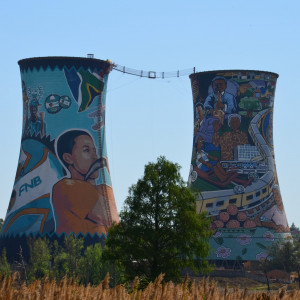Circular economy modelling in Africa – introducing FRAMES

Cambridge Econometrics recently coproduced a series of reports on the ‘Circular Economy in the EU-Africa Cooperation’ for the European Commission’s DG Environment. Part of Cambridge Econometrics’ contribution included analysis using FRAMES, a new modelling tool developed by Cambridge Econometrics for analysis of emerging and data-poor economies. In this article, we present FRAMES, review the DG Environment case study, and discuss further unique possibilities for analysis that FRAMES offers.
The challenge: modelling the circular economy in African countries
The modelling team at Cambridge Econometrics is excited to announce the development of a new model, FRAMES[1], which expands the scope of individual countries to which we can turn our economy-energy-environment (E3) modelling analysis.
At Cambridge Econometrics, modelling of policy questions related to the economy-energy-environment nexus is typically conducted using our flagship model, E3ME. E3ME boasts a comprehensive coverage of the global economy, and a detailed sectoral disaggregation of results across a range of economic variables. E3ME is therefore best suited to analysing economic policy questions at the global scale, or when analysing one of the major economies.
Due to E3ME’s extensive data requirements, however, many smaller and mid-sized countries are represented in the model as part of larger, aggregate, ‘regions’. When Cambridge Econometrics participated in a recent study analysing the impacts of circular economy activities in a selection of African countries, many of these countries did not exist as standalone regions in E3ME: Nigeria and South Africa could be analysed individually, but Kenya, Morocco, Ghana, Senegal, Egypt and Rwanda were only covered as part of the aggregate ‘Rest of Africa’ region in E3ME.[2]
We needed an E3 model that could analyse and assess the economic and environmental impacts of circular economy activities in these countries individually. But the complexity does not stop here, modelling circular economy activities (which include the reduction, reuse, refurbishing, repair, and recycling of waste) are challenging, as they involve complex interactions between different sectors and agents in the economy.
Analysis of these mechanisms requires a full-economy model, and one that can capture input-output relationships among many sectors. But models that capture all of these effects typically have quite extensive data requirements and are ill-suited to small and mid-sized countries that may have more limited data availability.
The FRAMES model – explained
Enter FRAMES, a new model which allows exactly this kind of focus on individual sectors in countries which have limited data coverage.
FRAMES is a close cousin of E3ME, Cambridge Econometrics’ flagship global macroeconometric model. Both are post-Keynesian demand-led models built on an input-output framework, and both capture the interactions between the economy, energy use and the environment. As a more flexible and versatile single-country model, however, FRAMES is as capable of analysing the employment impact of automation in Chile as it is of assessing the impacts of climate policies in Bangladesh.
At its core, FRAMES is built on the sectoral relationships embedded in input-output tables, and supplements these with full-economy relationships between output, employment, incomes, consumption, investment demand and trade. Like E3ME, FRAMES ties these economic variables to energy demand and carbon emissions, allowing a full analysis of the energy use and climate impacts of different policies.

Figure 1 – Overview of linkages in FRAMES
A lightweight and flexible model
Despite its detailed mechanical representation of the economy, FRAMES has surprisingly light data requirements. FRAMES requires only a single year of historical data to function, along with baseline projections of population and GDP. For the DG Environment circular economy study, we populated the FRAMES model using data from Eora’s input-output tables, which disaggregate economic and energy variables by a detailed 26-sector classification. We calibrated this sectoral data using economic, employment, population and energy aggregates from the World Bank, UN, ILO and IEA respectively, and used baseline projections of population from the UN and GDP from the IMF.
The secret to such lightweight data requirements is that FRAMES combines data from these sources with parameters for behavioural relationships that have been econometrically estimated in E3ME. Estimating these relationships requires detailed time-series data across a range of variables, which are not always easily available in many smaller and emerging economies. By borrowing parameters associated with wider regional aggregates in E3ME (such as ‘Rest of Africa’ in the case of the African countries analysed in the DG Environment project), FRAMES can circumvent such limitations.
FRAMES is also a highly flexible model, capable of adapting to the requirements of each project. This is true both in terms of scenario inputs, which can be designed according to the specific needs of the project, but also in terms of the baseline projections used, the level of sectoral detail, assumptions regarding revenue recycling and cost pass-through, and so on.
As a single-country model, one of FRAMES’ limitations is that it cannot capture the interactions between countries. FRAMES can describe the impacts of a Ugandan fiscal stimulus on the Ugandan economy, but will not capture its impacts on Tanzania. Accordingly, FRAMES is best suited to analysis of policies at the national and sectoral level, as opposed to the regional or global levels.
Case study: Analysing the circular economy in Africa
These features meant that FRAMES was perfectly suited to analysing circular economy activity the six countries selected for the DG Environment study that were unavailable in E3ME: Ghana, Morocco, Kenya, Egypt, Rwanda and Senegal. Our analysis focused on a narrow set of circular economy activities in five key sectors within each of these countries, as described in the table below.
| Sector | Circular economy activities |
| Waste | Higher collection & recycling rates |
| Agriculture | Reduced food loss in supply chain
Greater use of organic fertilizers as agricultural inputs |
| Electronics | Greater recycling of materials from e-waste
Greater use of recycled metal and plastic as electronics manufacturing inputs Reduced e-waste imports |
| Plastics | Greater use of recycled plastic feedstock as plastics manufacturing inputs |
| Construction | Greater use of recycled non-metallic minerals as construction materials |
Many of these activities involve complex interactions between different agents and sectors. For instance, the greater use of recycled materials in construction implies a shift in intermediate demand away from the raw materials sectors towards the recycling sector. This in turn has implications for employment and incomes in these sectors. The net employment impact across all these sectors will depend on their relative labour intensities: if the growing recycling sector is more labour intensive than the shrinking raw materials sectors, then net employment may increase. Furthermore, changes in aggregate employment and incomes will in turn affect aggregate demand and aggregate prices, which will have further impacts on employment and incomes in these sectors.
Additionally, a circular economy transition would require investment in recycling facilities and logistical upgrades in the food supply chain, which would directly impact demand for a variety of sectors such as construction. Furthermore, reductions in food losses in the agricultural supply chain would lead to productivity improvements, allowing output per worker to increase.

Figure 2 – Modelling circular economy activities
Like E3ME, FRAMES offers the ability to analyse these interactions across a range of different scenario activities simultaneously, while assessing their impacts on specific sectors relative to a baseline scenario.
The results of our modelling of circular economy activities in Africa showed that they would drive increases in GDP, employment and CO2 emissions. Much of the GDP impact would be driven by increases in agricultural productivity, while a further contribution would be made by the investment stimulus required for the circular transition.

Figure 3 – Aggregate results from the modelling
The sectoral results reveal that circular activities would drive higher output in the agricultural, recycling and construction sectors. The agricultural sector in particular would see growing employment and incomes, a consequence of the productivity gains from reducing food losses in the supply chain. The gains to the recycling sector would outweigh any losses to raw materials sectors – indeed, our analysis suggests that in some cases the ‘rebound effect’ from higher incomes would mean that demand for these raw materials sectors would increase overall relative to the baseline. The construction sector, meanwhile, would benefit from the increase in investment needed to achieve this circular transition. Other sectors would see a smaller percentage impact, as the higher output from the sectors discussed above would flow through to the wider economy via supply chain effects and higher labour incomes.

Figure 4 – Sectoral results from the modelling
A world of possibilities
As we move into a decade in which the transition towards a climate-neutral world reaches a critical juncture, and in which global development and demographic change will continue apace, the need for analysis to guide policies and pledges at a national level has never been greater. Challenges such as generating broad-based growth, changes in global material and energy demand, automation, environmental pollution and trade protectionism will affect different economies in different ways, and a one-size-fits-all policy response will not suffice.
To understand the dynamics of these challenges at a national level, a full-economy model is required, and in particular one that is built on a demand-led framework that can account for permanent changes to the trajectory of an economy as a result of policy measures. We have developed FRAMES to respond to this need, and we are excited to discover what new insights it will bring.
[1] The ‘FRAMES’ acronym stands for the ‘Framework for Modelling Economies and Sustainability’.
[2] Kenya and Egypt have since been added as standalone regions in the latest E3ME update.
Get in touch
If you would like to learn more about how FRAMES can be used for analysis of economic and environmental policy, please get in touch with Michael at [email protected].
